VANISHING LINES
TIME and SPACE
Time. To cope with it, to build for myself a map or a perspective of it never were my strong suit. With space, on the other hand, I always was more comfortable. So for instance if in music I can find my way, it seems to be only when I see it as a metaphor of architecture.
My production of images is more or less evenly distributed between two directions : either compositions of forms and colours which have meaning for me, or attempts to draw landscapes in time, presumably in an attempts to conform it to the orders of space.
INSTANTS and DURATION
The exhibition Quand la Photo Prend le Temps at the Médiatine was for me an opportunity to present a variety of images condensing events somewhat longer than instants.

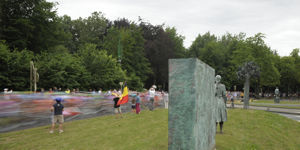
My Momentanés were a series of images done in the summer 2010, each a condensation of several shots taken from a unique viewpoint in the Cinquantenaire Park. Depiction not of an instant, but of a moment - lasting between two minutes and two hours. The exact contrary of a snapshot. No blurring here, but the combination in one image of a series of several shots spread over time.
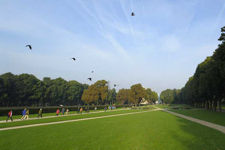
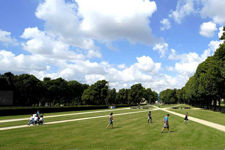
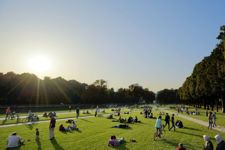
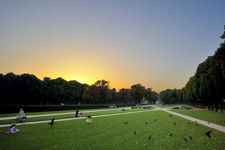
The videos of the series Turbulences appeared as a disintegration of space by a composition of contradictory movements
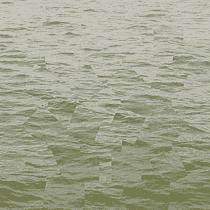

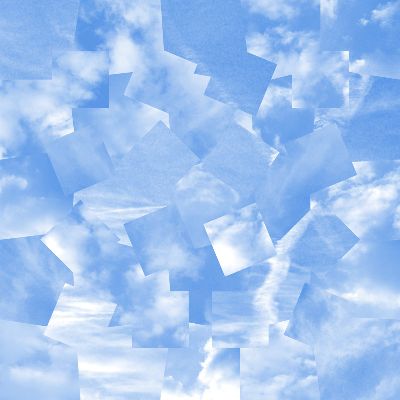
In the Littératures Alimentaires series, some images were the narrative of a season from the narrow angle of the succession of morning fruits reduced to their peels. Other images were stop-motion videos which from the slow drying of carrot peels recreated a touching choreography.
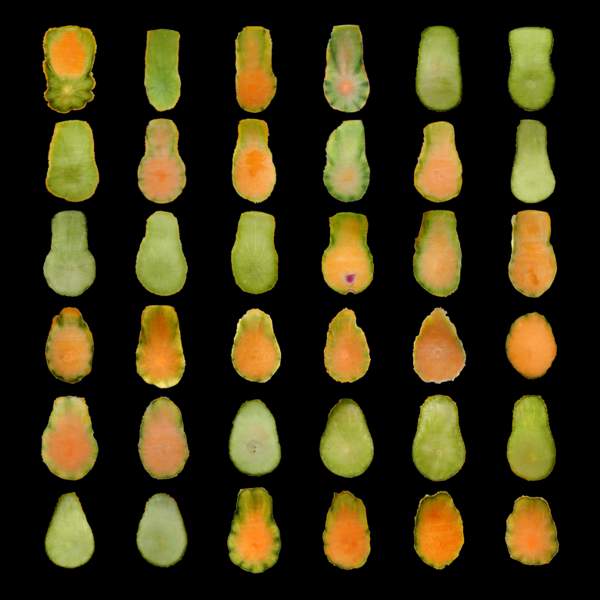
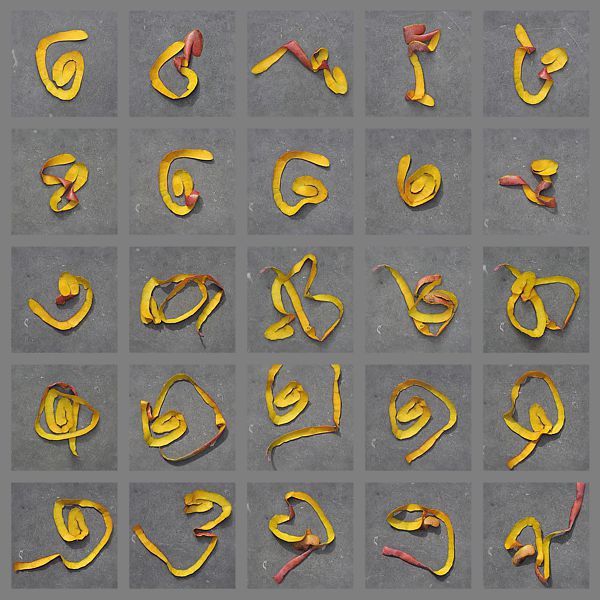
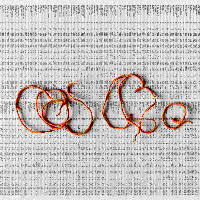
All these are devices which deal with the problem of the capture of duration through either juxtaposition or condensation. Metonymies and metaphors of time.
BLURRING, IMPRECISION or FORM ?
To distance oneself from the precision of photography in its capture of reality is an aesthetic pleasure. We care less about the thing than about its image. The movement which at the end of the nineteenth century endeavored to make a return of photography from the documentary to the aesthetics and which was called Pictorialism rejected precision and cultivated haziness. But blur can be more than complacency vis-à-vis technical imperfection; it can also, and very distinctly, be the inscription of the movement, and a clear articulation of space and time.
Photography is par excellence the media for a capture of time in the rectangle of an image. Do we get here some mere annihilation, or a possibly truthful translation ? More than painting, which in all times has attempted to freeze the flow of history in meaningful moments, photography, through its very technique, has had to give definite answers to the question : what to do with time, with movement ? And to this question photographers have given a great variety of answers : bougé, flou cinétique, filé, etc.
It is now left for us to search there for the inspiration for works that will make visible and maybe will transform our peculiar way of living in time.
The VANISHING LINES
One day coming back by train from Antwerp, the idea occurred to me of taking pictures of the landscape, just to see what a long exposure would produce.
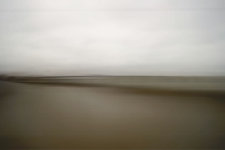
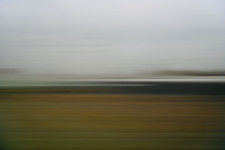
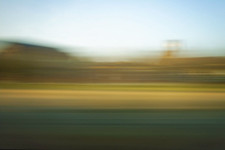
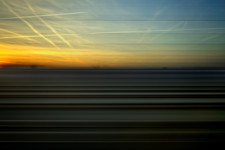
Disappearance of the thing figured in favor of the pictorial surface. Just as the painter's touch makes obvious the primacy of painting over representation, the blur pushes back the object to makes us better see the image.
When Blur becomes Form
Some of the images thus produced may look like perfect abstractions, with diversely coloured horizontal bands. The pictorial aspect is here obvious. An art built with chance and blur.
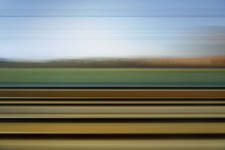
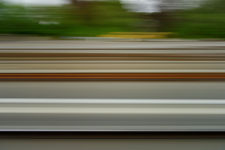
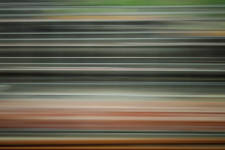
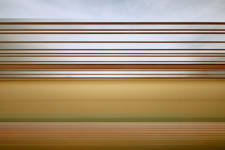
Obviously, abstraction here is not absolute : we know that figuration is not just a matter of drawing, and that we may also represent through colours.
The Rule of the Game ...
I wanted here to explore the possibilities of a simplifying hypothesis : the camera is set on a tripod, aimed to the horizon, and perpendicular to the movement of the train. The blurring of the landscape elements shall inscribe horizontal lines only. Of course the deviations from this rule have to be corrected -as well as the optical imperfections of the lens- through the digital processing of the raw file.
... and the exceptions which confirm the rule
In principle I was interested in static scenes and the shaking of the train on switches could give appealing results, but were not looked for. Object with haphazard movement, like flags in the wind, shall be rendered in a way that escapes the simple geometry of our rectilinear blur and won't be part of this series.
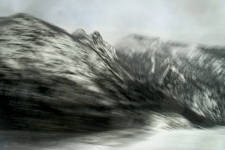
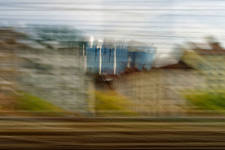
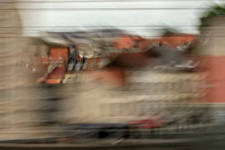
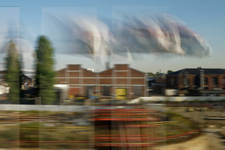
Filé
In my train pictures, if some object accompany our movement, I get a filé effect which isolate the object in a field of confusion, like when the photographer follows the movement of a moving object in a stable environment.. Among those traveling companions, there is of course the occasional shadow of the train. Note that in this case the blur is not modulated by distance.
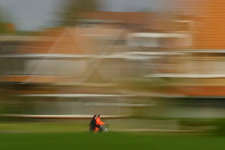
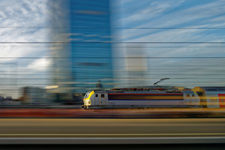
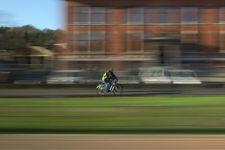
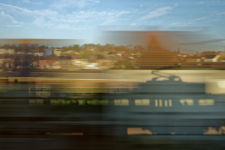
Those apparition in the image may be visually engaging, but they are not at the core of what shooting from a train makes us discover.
Sometimes a particular case happens when the tracks are slightly curved, concave on the side the camera is aimed at. If some tree, house, church spire happens to be just at the centre of the movement, its image shall be perfectly sharp.
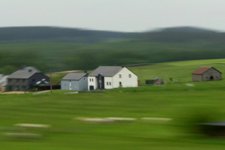
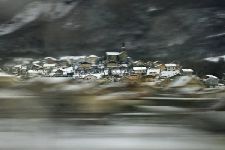
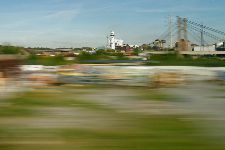
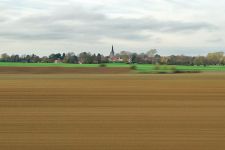
Ambiguity between figuration and abstraction
An outline parallel to the tracks becomes a sharp line, and the rest fades in haze. This partial persistence of a dimension of the object induces an ambivalence between figuration and abstraction. In those abstract compositions, forms squeeze in of which we can more or less well perceive what produced them : rails and window sills, tracks, paths and furrows, etc.
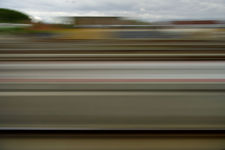
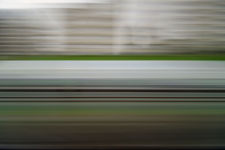
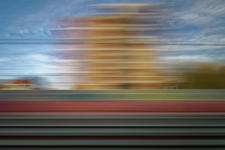
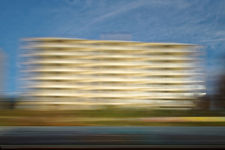
Chance and Luck
Objects reduced to a set of horizontal outlines acquire a problematic identity, and as riddles they unsettle our perception. For this moving perception, beings come to life which for a normal eye would be undetectable.
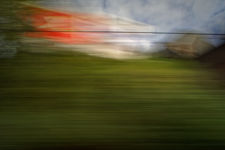
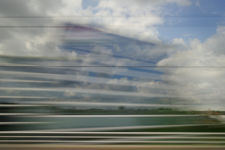
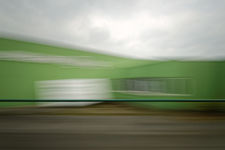

Landscapes made for blurring
Can this technique really be mastered ? With time, I ended up recognizing what in landscapes could give interest to the image, and exercising my vigilance to grab these occasions. But chance and luck still play a prime role. There is a huge difference between what I saw through the window of the train, and the image that would come up; in particular there doesn't seem to be any relationship between the beauty of the site and of the resulting image. Natural landscapes, with meadows and galloping horses, or autumn golden foliages, etc. shall give nothing with a long mobile exposure; it is no use trying. In Wallonia the landscapes are nice, and they would be a loss of time. The violence done to geometry implies that some architectural objet must lie close to the track. Il Flanders the houses an factories huddle along the tracks -environmental nonsense, but a better subject matter for moving perspectives. And experience taught me that building look better for a blur when they sit askance.
Skies and Clouds
The image of an infinitely distant thing is perfectly sharp : we can observe it most often for clouds.
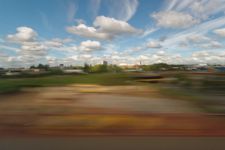
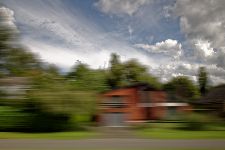
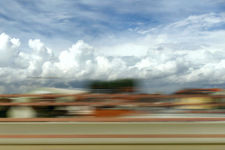
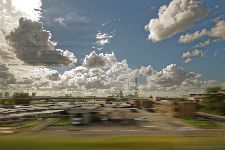
The sharp skies give depth to the landscape and play a great role in the composition of the image. I thus planned my excursions so as to capture pregnant cloud motifs. The interest of the cloud comes also from its way of expressing flows in a peculiarly slow rhythm.
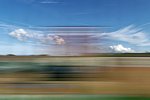
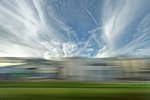
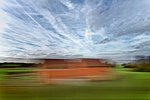
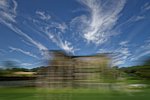
Speed and confusion
Those horizontal banding compositions, reducing the environment to a few chromatic values has a serene character, as if speed did erase all the disgraceful details of a world full of conflicts and ugliness. But sometimes the effect is just the contrary, and we see all the tumult and confusion which so impressed the voyagers in the first trains in the XIXth century.
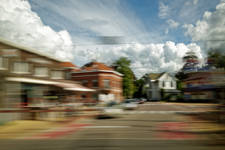
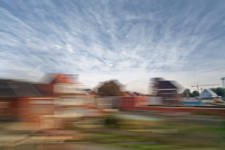
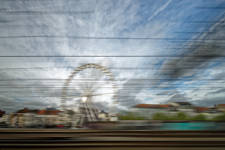
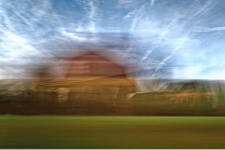
Digital directional blur
A question that could come up is : if the essence of those images is the horizontal blurring, why not just take a normal sharp picture, and then on the computer, apply to it some digital treatment called directional or movement blur ? You can see that in advertisings that want to express mobility or speed. Who could see the difference ? See those examples :
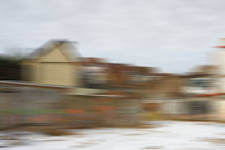
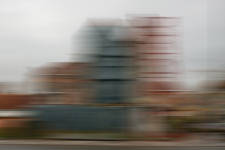
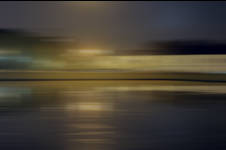
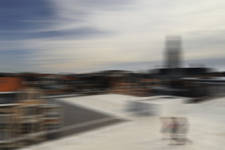
Actually there is a superficial resemblance of those digital blurs with our train blur, but the effects are radically different. In what the computer produces, the dispersion of RGB values is uniform in all the image or repartition along some contour, but in no way does it result from the positions of objects in space.
DYNAMIC PERSPECTIVE
These images which express movement by the digital directional blur lack an essential ingredient: the differential rendering of depth by a variable blur, which can only bet produced by train photography. Those synthetic blur images lack spatial depth. The uniqueness of the train pictures is the differential rendering of distance by blurring.
The backgrounds (clouds, sky, asters) stay sharp, objects in the landscape are moderately blurred, and the closer become horizontal abstractions.
For a given speed of the train, according to the remoteness of an object, its projection on the sensor shall be accordingly wide. Lets suppose that the train rides at 60Km/h, and we choose a 1/2" exposure; the relative displacement of all objects is +/- 8m. For an objects at 5m from the track, it means a 75° angle, and for a 24mm lens it covers the width of the sensor. But for a cloud at 10Km, the visible movement covers only 0,05°, which means 0,2mm on a 24x36mm sensor.
Through the complex but exact relationship between distance and blurring, one can say that the 3-D space of the landscape is to be seen faithfully rendered in the 2-D image. Thus it is a type of perspective.
Just as classical perspective is limited to the projection of the world on a flat (and usually vertical) surface through a single point, the train photography adds another type of space rendering.
The instrument, instead of the camera oscura, is here the combination of the running train and the camera. The rigorous reduction of the space to the image might allow the restitution of space from the image. I thought it fit to call it dynamic perspective.
The System of mutual shutterings
The variation of the intensity of the blurring related to distance is not the only observable effect of dynamic perspective. Another concerns a special way of occultation between object. We know that in the traditional and static spatial representation, to the projection of points and lines, one must add the screening effect of objects, the closer hiding the farther. In our moving photography, there is a peculiar occultation effect : the object partly hides the ones which are behind; and it may also make them sharper. The closer objet acts as the shutter of the camera, reducing the exposure time for the distant objects, which makes them sharper than if they were visible for the entire exposure..
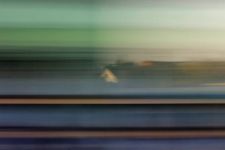
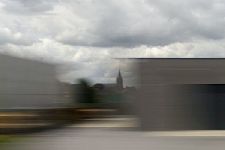
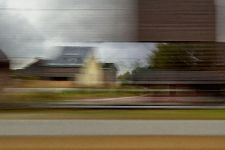
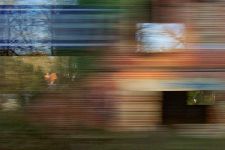
The shape of the objects changes because of the proximity and interposition of other objects. A complex system, which could in no way be synthesized with a computer.
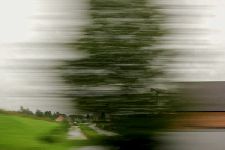
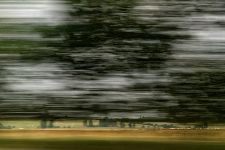
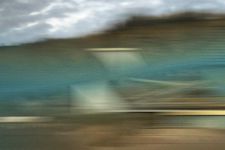
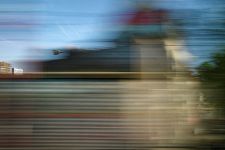
This effect is most noticeable with foliages, which are not only blurred, but present a structure resulting from the mutual shuttering of all the leaves with each others. This complex game of mutual shuttering no doubt produces the most interesting formal surprises. Another amazing effect is the apparition of strange forms due to relative rotation of surfaces at angle to the axis of vision.
A new perceptive paradigm ?
To draw makes us see better; train photography is another way of enhancing our vision. However well founded or not the assimilation of a figuration process to a perceptual paradigm might be, the practice of this technique has proved to be a transformation of my sensitivity and an opportunity to discover anew the environment.
TIME REDISCOVERED
And this series of photographs made me discover new aspects of time. I'm going on the internet to check tomorrow's weather. I try to choose the right moment for the right place, the best lighting considering the season and the day. Sometimes I get long stays in the stations, and may choose several back and forth through some alluring place. At the window I watch the occurrence of the expected or unexpected scene, honing my reflexes. At any time I correct the exposure time to adapt to the speed of the train and the distance of the external things. Suddenly the picture is taken and the result is sometimes good. It remains to sort, and then process the digital data to make images. A work of patience.
In conclusion, this dynamic perspective may well prove to be a kind of healing reconciliation with Time.
